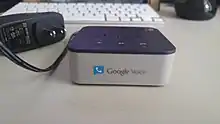| Type | private corporation |
|---|---|
| Industry | computer networking |
| Founded | 2010 in Cupertino, California[1] |
| Fate | sold to Polycom, with Poly then sold to HP. |
| Headquarters | , United States |
| Products | analog telephone adapters, softphones |
| Brands | Obi, ObiTALK, OBiON |
| Parent | Polycom |
| Website | www |
Obihai Technology was a company that manufactures analog telephone adapters that supported Session Initiation Protocol (SIP), XMPP, and Google Voice[2] compatible Internet telephony. Obihai was sold to Polycom in 2018, with Poly and Plantronics sold to HP in 2022. Most items in the former Obihai product line have been either rebranded as Poly or discontinued.[3]
History
The company, based in California's Silicon Valley, was founded in 2010 by Jan Fandrianto and Sam Sin, the same people who introduced the first analog telephone adaptors as Komodo Technology in the 1990s and formed Sipura Technology in 2002. Both prior companies were acquired by Cisco Systems, in 2000 and 2005 respectively,[4] and integrated into that company's Linksys division. Linksys was sold to Belkin in 2013.[5]
In January 2018, Polycom acquired Obihai. Polycom "expects to add more cloud-based capabilities and Analog Terminal Adapter solutions to its solutions portfolio". The deal is expected to close early in the first quarter of 2018.[6] In 2022, Poly was sold onwards to HP.
In December 2021, Obahai's consumer-oriented analogue telephone adapter line was discontinued, with support ended in December 2023.[7] This leaves no hardware ATA's from any source available for purchase for use with the Google Voice service.[8]
Products

Obihai was notable primarily for manufacturing analog telephone adapters that connected standard push-button telephones to the Google Voice service using a wired or wireless broadband Internet connection.[9] As Google's voice over IP service is inexpensive (and, in some cases, was free), hardware that allowed the service to replace conventional landline telephony reduced costs to subscribers.[10]
The hardware came in various configurations, including OBi100 (1 x FXS, to connect to one phone), OBi110 (1 FXS + 1 FXO, to connect to one phone and one conventional outside line), OBi200 (1 x FXS, 4x VoIP services, T.38, USB, [wi-fi, BT optional extra]) and OBi202 (2 FXS + LAN with T.38, USB, wi-fi optional extra).[11] The devices, which at one point were distributed through US vendors such as Walmart, Newegg and Amazon, were normally sold unlocked and unconfigured.[12] The user was able to configure logins for multiple, simultaneous providers.[13]

Obihai operated its own preconfigured OBiTALK VoIP service to allow direct calling between its branded devices (using **9 and a nine-digit serial number), as well as a companion OBiON softphone app for Android[14] and iPhone.[15]
There was also a Service Provider Template for various individual providers (such as Anveo and Phone Power);[16][17] earlier devices used an online wizard to automate the configuration process.[18]
Google Voice support, a popular feature due to the low cost of service,[19] was temporarily broken when that service dropped XMPP support in May 2014[20] and officially restored in September 2014.[21] It was again broken at the end of 2017 for OBi100/110 devices due to update of Google certificates and previous end of support of Obi100/Obi100 in 2016. Later old certificates were temporary restored back by Google and service stopped again in May 2018. At the same time a community found a way to put a correct new Google certificates into Obi100/110 even without vendor support and describes it in www.obifirmware.com (anonymously).
The 2021 discontinuation of the Obahai 200-series analogue telephone adapters left no hardware devices from any source able to connect to the consumer Google Voice service. Google has no plans to make this capability available in the future.
See also
References
- ↑ "SEC FORM D". www.sec.gov.
- ↑ "Three Things You Should Know About Google Voice". PC World. 30 April 2012. Retrieved 4 November 2014.
- ↑ https://www.obitalk.com/info/products
- ↑ Logan Abbott. "Company Spotlight: Obihai Technology Reinventing VoIP a Third Time". Voxilla. Archived from the original on 2012-07-09.
- ↑ Ngo, Dong. "Belkin completes acquisition of Linksys from Cisco". CNet. CBS Interactive Inc. Retrieved 8 October 2013.
- ↑ Polycom Inc. "Polycom Announces Agreement for Strategic Acquisition of Obihai Technology". Retrieved 13 March 2018.
- ↑ https://www.obitalk.com/info/products
- ↑ https://support.google.com/voice/thread/211226833/hardware-replacement-device-for-obi-200?hl=en
- ↑ "How to Switch to VoIP and Ditch Your Home Phone Bill Forever". HowTo Geek. Retrieved 4 November 2014.
- ↑ Investopedia (26 April 2011). "6 Common Subscriptions You Can Live Without". Forbes. Retrieved 4 November 2014.
- ↑ "WiFi Setup". Obihai. Archived from the original on 28 October 2014. Retrieved 4 November 2014.
- ↑ "OBi110". PC Magazine. Retrieved 4 November 2014.
- ↑ "Obihai VoIP". Target PC. Archived from the original on 2014-11-03. Retrieved 4 November 2014.
- ↑ Obihai Technology. "OBiON Android". Appszoom.com. Retrieved 4 November 2014.
- ↑ "Obihai Mashes Up Mobile, Landline, VoIP & Social Networking". TMCnet. Retrieved 4 November 2014.
- ↑ "2011 VoIP Device of the Year: Obihai OBi110 for Google Voice". Nerd Vittles. Retrieved 4 November 2014.
- ↑ "OBiTALK Approved Service Provider Program". Obihai. Retrieved 4 November 2014.
- ↑ "OBi100 ObiHai 100 Configuration and Review". Callcentric. Retrieved 4 November 2014.
- ↑ Marcelo Rodriguez. "Google Voice with OBi on your regular phone". Voxilla. Retrieved 4 November 2014.
- ↑ "Obihai Offers New Low-Cost Home Phone Options As Technology Change At Google Ends Free Service". TechCrunch. 18 March 2014. Retrieved 4 November 2014.
- ↑ "Google Voice and Obihai Update". Obihai Technology, Inc. Archived from the original on 2014-11-26. Retrieved 4 November 2014.